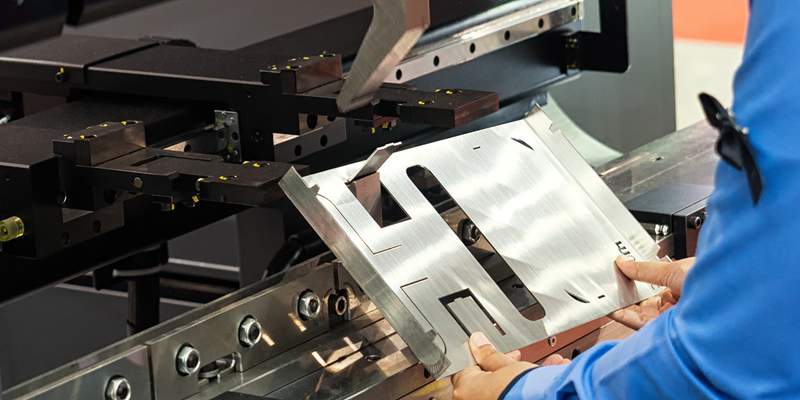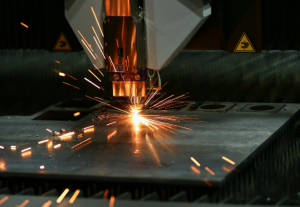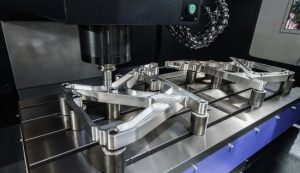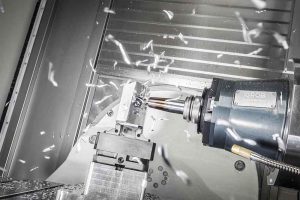To optimize material usage in sheet metal prototypes, employ methods like laser cutting and water jet cutting for precision, use CNC bending and forming for exact shapes, and apply efficient part nesting to maximize material utilization and minimize waste.
Laser Cutting
Laser cutting has a reputation for accuracy, and the ability to maximize sheet metal use in prototyping makes it highly preferred. The process uses a concentrated laser beam to cut steel, aluminum or titanium materials with accuracy up to +/- 0.05 mm and dramatically reduces waste while increasing the detail level in produced parts
Precision and Efficiency
Laser cutters can work with very high precision, often of +/- 0.1 mm which allows for design complexities and minimal material waste. For example, in the manufacturing of complex parts like automotive or electronics casings, this level of precision will ensure high adherence to design specifications reducing post machining processes.
Software Integration
Powerful nesting software is obviously a key element to achieving the best possible material utilization. These programs can reach material utilization up to 90% by systematically placing the cutting parts on a metal sheet. For instance, machinery companies Trumpf and Amada offer sophisticated laser cutting systems with accompanying software that they say improve sheet utilization by 5-10% over more traditional methods. Algorithms in the software order parts for as much of their structure facing down to make sure that there is less wasted powder, and thus often lower material prices.
Speed and Automation
Laser cutting is done at a speed that adds to its efficiency. A typical 90 minute laser cutting operation has been reduced to less than half an hour for a standard 4×8 foot metal sheet, depending on the cut pattern complexity. This is essential for the improvement of lead times and an increase in plant throughput. The process does not require manual intervention, which reduces labour costs and the risk of human error making this operation very cost-effective as well.
Reduced Scrap and Rework
Because of the precision that is achieved via laser cutting, there will not be as much scrap metal. It’s easy to imagine how small scrap savings of even a few percent would result in significant cost reductions at industrial scale. So, for example, a typical sheet metal fabrication shop might reduce the scrap material it produces by 10-15% if they were able to use laser cutting instead of conventional mechanical-cutting methods. In addition to preserving resources, it also makes sense in line with sustainable manufacturing as less waste and the energy required for recycling processes is minimized.

Water Jet Cutting
Water jet cutting is a sheet metal prototyping based technology that uses high-pressure water mixed with abrasive particles to cut into materials. This process can cut all booth metals and composites without adding heat or stressing the part.
Mechanism and Capabilities
Water jet cutting operates by using a high velocity stream of water (up to speeds in excess of 900 m/s) with fine granular abrasives such as garnet. This allows the water jet to slice through up to 200mm of steel with ease. Water jet cutting has an accuracy of approximately +/-0.1 mm, which is more than enough to generate fine contours and shapes with excellent adherence to CATIA or SolidWorks art renders
Conservation and Efficient Utilization of Material
We keep more material and lose less in water jet cutting, as it can cut closer to a material’s boundaries than most other forms without waste. The parts to be cut are grouped in a way that the software will use an advanced nesting technique. For example, software tools simply nesting parts in one sheet with very little gaps can improve material utilization to over 85% and sometimes more.
Less Material Distortion, Less Waste
Water has a lot of advantages, first and foremost is that lack of heat-affected zone (HAZ) because there was no thermal cut like with the torch cutting processes. This is especially beneficial with metals known to warp or change shapes upon heat. This leads to less waste of that materials and fewer reworked parts because they had warped.
Versatility Across Materials
Versatility – this is one of the trait that makes water jet cutting different. It is applicable to all metals, including hardened tool-steels and titanium, as well as other types of material such the composites or laminates. This adaptability also makes it applicable for use in a variety of industries where rapid prototyping is commonplace, including the aerospace and fashion industries that frequently prototype with different materials.
CNC Bending and Forming
CNC (Computer Numerical Control) bending and forming are critical processes for sheet metal prototype to minimize the material used. Cutting is a process that incorporates precision equipment to transform metal sheets into predetermined shapes without elimination of material.
Precision and Reduced Waste
By calculating the allowance accurately, CNC bending and forming machines are designed to reduce wastage of material. The bending process can reach angular tolerances up to +/-.5 degrees, meaning every bend is made according to design intent which vastly reduces the amount of rework or corrections that often lead towards wasted material.
Planning ahead with software
For CNC bending, the software is indispensable (that needs to simulate a complex sequence of bends) that can find out problems in advance before production. This planning of pre-production also assist in changing the bending sequence or part design so that material utilization will be approached to its optimized. For instance, engineers can see part layouts and bending sequences in software such as AutoCAD or SolidWorks, which could theoretically improve utilization rates through the optimization of bend order and reduction of cuts.
Efficiency in Production
The speed of CNC bending machines is remarkable, being able to manufacture many bends in a single minute depending upon the part complexity and size. The speed also means that not only is production throughput improved but the total operational cost for each part. When the prototyping phases of design development have a fast turnaround time, material use can be further fine-tuned and optimized more quickly for future iterations.
versatility in material handling
This ability is not only restricted to regular sizes of metal sheets by; CNC bending machines are versatile in sheet thicknesses and materials by which they can easily adjust according to the requirements without demanding extra tooling costs. That adaptability makes it possible for fabricators to apply the same configuration to other prototypes, eliminating costly setup changes and achieving even greater material utilization.

Efficient Part Nesting
Highly efficient nesting of parts can make a good difference for material utilization in sheet metal prototyping. This strategically nest component designs onto a metal sheet to make the best uses of material.
Optimization Software and Algorithms
The right nesting software, such as SigmaNEST or NestFab, are key to getting material utilization rates upwards of 90% and even more. These software run algorithms that are created to store parts in the most space efficient manner. This would be based upon aspects such as the shape, size and number of parts plus material sheet dimensions. An example in software might be to have the smaller pieces lurk around within a big piece, making sure it used up as much area that would normally just get thrown away.
Applications in the Real World and Effects
Large industries using high cost material such as aerospace and automotive manufacturing, efficient nesting provides huge savings. Another example comes from an aerospace parts manufacturer who reported reducing material scrap by 15%, resulting in annual savings of hundreds of thousands. In yet a fourth production case, one automotive components supplier was alleviated to increase the number of parts produced per sheet by 10 percent-resulting in significant bottom-line impact through reduced material purchase and waste handling.
Personalized and Adaptable Nesting Practices
Nesting software has a high level of customization that provides manufacturers the freedom to design nesting process for their particular projects. This may involve changing the part directions to accommodate material grain or adjusting the cutting path for minimizing tool wear and increasing cut speeds. Therefore, the ability to adjust for specialized materials or a complex part geometry are two things that you may find during your testing of these additional features.
Connectivity for Increased Efficiency
It is really important to be able seamlessly integrate your nesting results with the CNC machining processes. The coordinates and cutting paths are then fed in to CNC laser cutters, plasma cutter or any water jet machine directly. This integration not only shortens setup time for production runs, but also guarantees that the material savings forecasted in advance of nesting are truly realized while manufacturing. One sheet metal fabrication shop, for instance, integrated nesting software with their laser cutting systems which lead to a 20% reduction in setup time and increase material utilization by more than 5%.
Feedback Loops
Most advance nesting programs offer feedback that can be used to enhance and perfect the automation of the process from real-life results integrated within them. This continual improvement process provides a means for acclimating to new materials, altering production requirements and any upcoming industry standards that may come in the future-ensuring nesting efficiency performs is at its optimum level over time.







